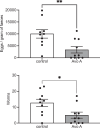A new class of natural anthelmintics targeting lipid metabolism
- PMID: 39746976
- PMCID: PMC11695593
- DOI: 10.1038/s41467-024-54965-w
A new class of natural anthelmintics targeting lipid metabolism
Abstract
Parasitic helminths are a major global health threat, infecting nearly one-fifth of the human population and causing significant losses in livestock and crops. Resistance to the few anthelmintic drugs is increasing. Here, we report a set of avocado fatty alcohols/acetates (AFAs) that exhibit nematocidal activity against four veterinary parasitic nematode species: Brugia pahangi, Teladorsagia circumcincta and Heligmosomoides polygyrus, as well as a multidrug resistant strain (UGA) of Haemonchus contortus. AFA shows significant efficacy in H. polygyrus infected mice. In C. elegans, AFA exposure affects all developmental stages, causing paralysis, impaired mitochondrial respiration, increased reactive oxygen species production and mitochondrial damage. In embryos, AFAs penetrate the eggshell and induce rapid developmental arrest. Genetic and biochemical tests reveal that AFAs inhibit POD-2, encoding an acetyl CoA carboxylase, the rate-limiting enzyme in lipid biosynthesis. These results uncover a new anthelmintic class affecting lipid metabolism.
© 2024. The Author(s).
Conflict of interest statement
Competing interests: The authors H.Z.F., K.C.G. and F.P. declare the following competing interests: New York University is pursuing patent protection related to the use of AFAs as nematicides for which a US Patent Application No. 63/509,493 is currently under review and lists H.Z.F., K.C.G. and F.P. as inventors and New York University as applicant. The remaining authors declare no competing interests.
Figures





References
-
- Learmount, J. et al. Three-year evaluation of best practice guidelines for nematode control on commercial sheep farms in the UK. Vet Parasitol226, 116–123 (2016). - PubMed
-
- Charlier, J. et al. Initial assessment of the economic burden of major parasitic helminth infections to the ruminant livestock industry in Europe. Prev Vet Med. 182, 105103 (2020). - PubMed
-
- Siddique, S. & Grundler, F. M. Parasitic nematodes manipulate plant development to establish feeding sites. Curr Opin Microbiol46, 102–108 (2018). - PubMed
Publication types
MeSH terms
Substances
Grants and funding
LinkOut - more resources
Full Text Sources

